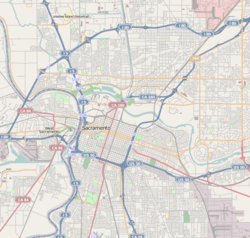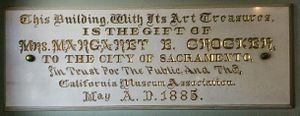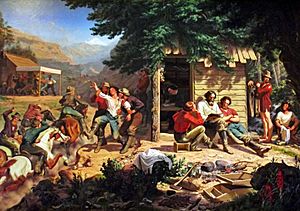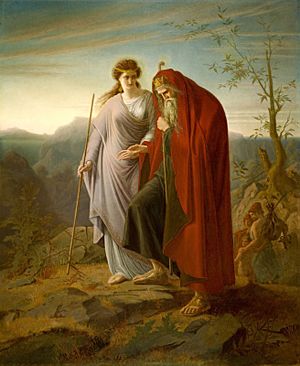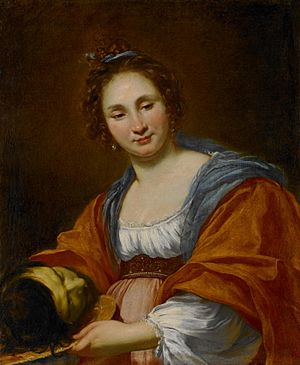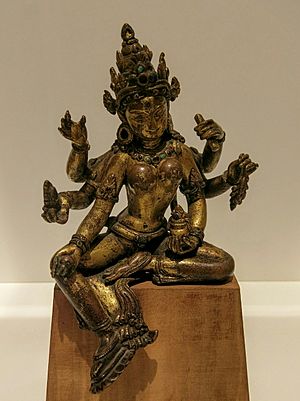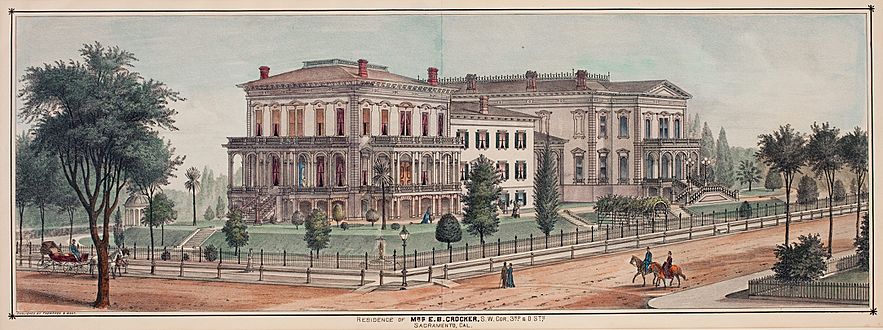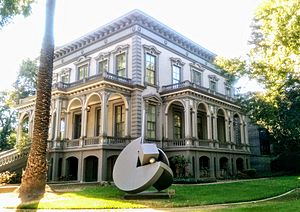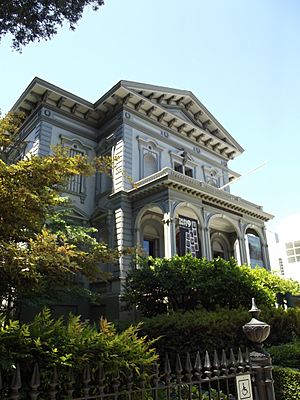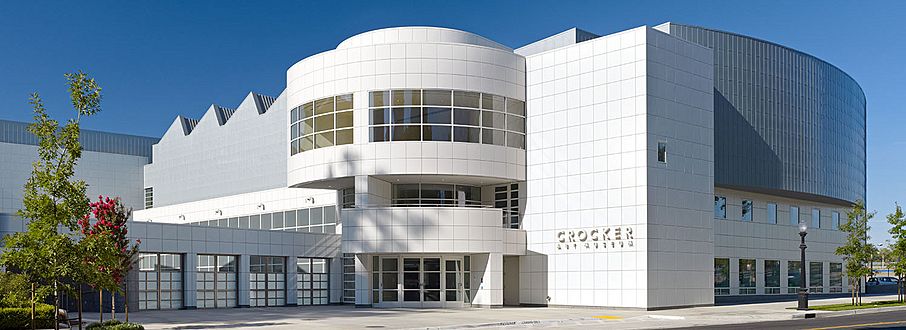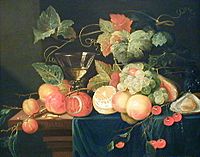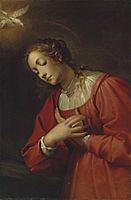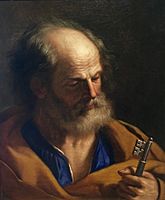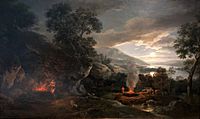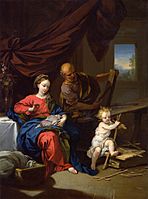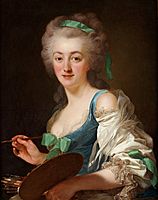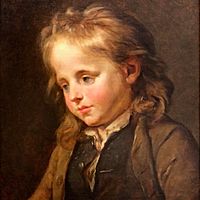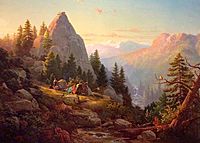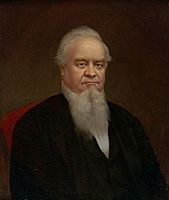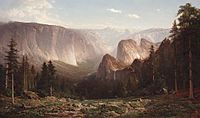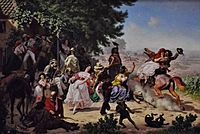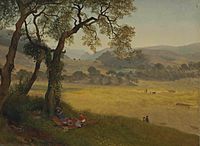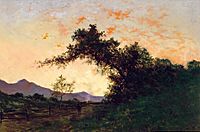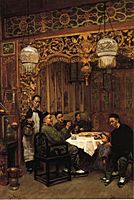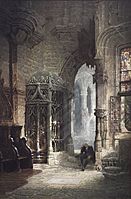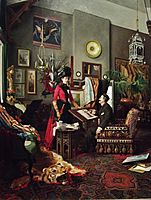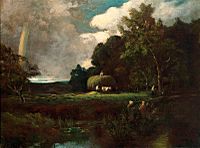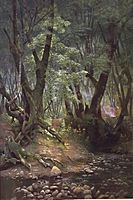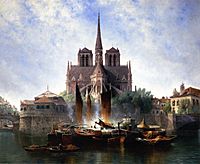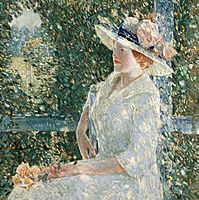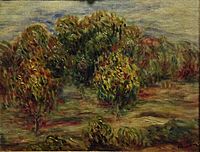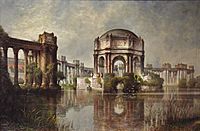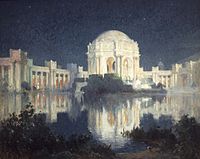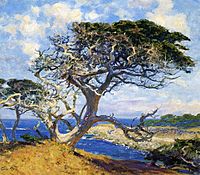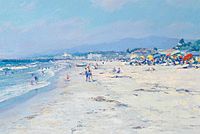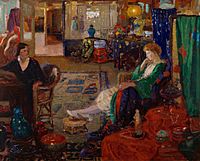Crocker Art Museum facts for kids
Quick facts for kids |
|
|
Crocker Art Museum
|
|
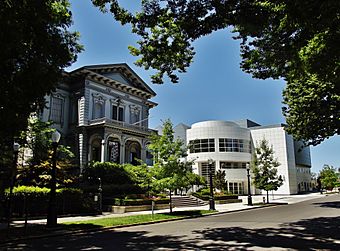
Old and new buildings of the Crocker Art Museum.
|
|
| Location | 216 O St., Sacramento, California |
|---|---|
| Built | 1871; addition 2010 |
| Architect | Seth Babson (1871); Charles Gwathmey (2010) |
| Architectural style | Victorian Italianate; Classic Contemporary |
| NRHP reference No. | 71000176 |
| Added to NRHP | May 6, 1971 |
The Crocker Art Museum, formerly the E. B. Crocker Art Gallery, founded in 1885, is the oldest art museum west of the Mississippi River. Located in Sacramento, California, the Museum holds one of the state's premier collections of Californian art. The museum contains American works dating from the Gold Rush to the present, European paintings and master drawings, one of the largest international ceramics collections in the U.S., and collections of Asian, African, and Oceanic art.
Contents
History
Edwin B. Crocker (1818–1875), a wealthy California lawyer and judge, and his wife, Margaret Crocker (1822–1901), began to assemble a significant collection of paintings and drawings during an extended trip to Europe, from 1869 to 1871. Upon their return to Sacramento, they set about creating an art gallery in part of their grand home at the corner of Third and O streets. The gallery became of the hub of social activity in Sacramento, hosting benefits for local organizations and welcoming prominent visitors including the Hawaiian queen, Liliuokalani (1878), President Ulysses S. Grant (1879), and Oscar Wilde (1882).
E.B. Crocker died in 1875. In 1885, his widow, Margaret, created a public art museum when she presented the E. B. Crocker Art Gallery and collection to the City of Sacramento and the California Museum Association, "in trust for the public," the contents of which were valued at the time at more than $500,000.
In 1978, the Crocker Art Gallery was renamed the Crocker Art Museum. In 2002, to accommodate a burgeoning collection and the needs of the growing population of Sacramento and California's Central Valley region, the museum commissioned the firm of Gwathmey Siegel & Associates to design a major addition. The greatly expanded Crocker Art Museum opened on October 10, 2010.
Permanent collections
Californian art and American art
The Californian art collection includes works dating from statehood to the present. The core collection of early Californian art was assembled by Judge E. B. and Margaret Crocker in the early 1870s. Prominent in their collection are works by the German-American artist Charles Christian Nahl, who brought the large scale and copious detail of European history painting to works depicting the California Gold Rush. The Crockers commissioned five major works from Nahl, including Sunday Morning in the Mines (1872).
The Californian collection continued to expand, and now contains 150 years of painting, sculpture, and craft media covering genres that include Impressionism, Abstract Expressionism, and Pop Art, and features artists including early Sacramento painter Amanda Austin, Norton Bush, William Keith, Thomas Hill, Granville Redmond, Edwin Deakin, Guy Rose, Gottardo Piazzoni, Joan Brown, Elmer Bischoff, Roland Petersen, David Park, Jess, Richard Diebenkorn, Mel Ramos, and Wayne Thiebaud.
The collection also includes American art from the late 19th century to the present. American impressionists and modernists are a particular strength, with artists including Childe Hassam, Robert Henri, Georgia O'Keeffe, Maynard Dixon, Marsden Hartley, Hans Hofmann, and Luis Cruz Azaceta.
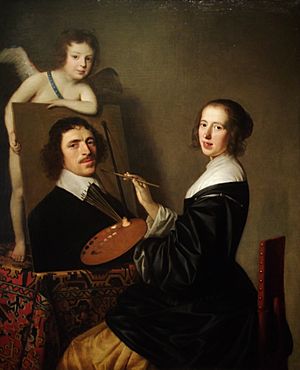
European art
Original collection
The collection of European art began with the Crocker family's trip to Europe, from 1869 to 1871. It was not a Grand Tour. The Crockers rented lodgings in Dresden for over a year, and traveled mostly in Germany. As a later director of the museum would write, "Mr. Crocker was a novice and completely susceptible to a kind of fraud in his anxiety to become the possessor of a large collection of masterpieces. He acquired in his wholesale search a collection of more than 700 paintings," most of them "not by the few famous names given him by the dealers in Munich and Dresden." (Works said to be by Rembrandt, Rubens, Poussin, Salvator Rosa, and even Leonardo da Vinci appear in the initial 1876 catalogue, but were reattributed in following decades.) However, among Crocker's purchases were a number of genuinely rare works by a broader array of artists than he realized, and for a brief time the Crockers possessed the largest private art collection in the United States.
Along with paintings, the Crockers also acquired 1344 Old Master drawings "and untold numbers of prints of rare craftsmanship." Systematic study of the origin and significance of these drawings began only in the 21st century.
Of more certain provenance were the numerous German and Central European paintings Crocker purchased, many by artists who were alive and working at the time. These 19th-century paintings would form the core of the European collection, along with a number of 17th-century Flemish and Dutch Golden Age still lives and genre scenes, as well as French and Italian works of the 17th and 18th centuries. Artists represented in Crocker's original collection include Maarten van Heemskerck, Jan Brueghel the Elder, Klaes Molenaer, Pieter Quast, Antonio Joli, Francesco Solimena, Paolo de Matteis, Claude-Joseph Vernet, Jacques-Louis David, Andreas Achenbach, and Karl von Piloty.
Later acquisitions
Recent gifts by philanthropist Alan Templeton have expanded the scope of the European collection to include works by Italian artists Guercino, il Morazzone, and Bernardo Strozzi, the Swedish portrait painter Alexander Roslin, and French artists Simon Vouet, Philippe de Champaigne, Charles Poërson, Pierre-Alexandre Wille, Louis-Jean-François Lagrenée, and Robert Lefèvre, as well as English portraitist Sir Thomas Lawrence, Austrian painter Josef Danhauser, and Dutch artist Abraham Hondius.
Gifts and promised gifts by the Beekhuis family of 67 19th-century Dutch landscapes are presented in the Beekhuis Foundation Gallery, including works by Johannes Hermanus Koekkoek and his descendants, and various painters of the Hague School.
The Crocker's holdings of European art after 1900 are small, but include one of Northern California's most significant collections of works by Renoir, in part due to gifts from the artist's grandson, Alain Renoir, a professor at the University of California, Berkeley. These include three small bronzes, two terra cotta relief sculptures, a Cagnes landscape painting, and works on paper, and also a ceramic vase by Jean Renoir. Works after 1900 also include two portraits of Crocker family members by Giovanni Boldini.
Works on paper
The collection of approximately 1,500 Old Master drawings include examples from the major European schools. Collection strengths include European drawings from the 17th and 18th centuries. Major drawings by artists such as Albrecht Dürer, Fra Bartolommeo, François Boucher, and Jean-Honoré Fragonard are represented. American photography and modern and contemporary California prints are also strengths of the works on paper collection.
Asian Art
The collection began with a gift of Korean ceramics by Judge E.B. and Margaret Crocker's daughter Jennie Crocker Fassett in the 1920s. The collection of Asian art is noted for its holdings of Chinese tomb furnishings and trade ceramics, and Japanese armor and tea ware. South and Southeast Asia are well represented through the William and Edith Cleary gift of more than 600 Indian and Persian miniature paintings and drawings, as well as Buddhist art from the region between Pakistan and Southeast Asia.
Ceramics
Since mid-century, the Museum has followed the development of notable Californian, American, and international ceramists such as Hamada Shoji and Lucie Rie. The history of ceramics is also explored through a collection of 18th-century Meissen porcelain tableware and in the works of ancient cultures dating to the Neolithic period.
African and Oceanic art
The collection of African and Oceanic art features a variety of objects created for daily life and traditional ceremonies. The art of the Asmat of New Guinea is strikingly evidenced in the towering memorials to ancestors, called bis poles.
The Crocker-Kingsley Exhibitions
A biennial exhibition has been held by the museum in cooperation with the Kingsley Art Club since 1927, and juried since 1940. Artists whose works have appeared include Robert Arneson, Elmer Bischoff, David Gilhooly, Ralph Goings, Roland Petersen, Mel Ramos, Fritz Scholder, and Wayne Thiebaud.
Museum buildings
Crocker family mansion and art gallery
In 1868, Judge Edwin B. Crocker purchased the property and existing buildings on the corner of Third and O Streets. He then commissioned Seth Babson (1830–1908), a local architect, to redesign and renovate the home into a grander, Italianate mansion. (Babson had previously designed the home now known as the Leland Stanford Mansion in Sacramento.) In addition, Crocker asked Babson to design an elaborate gallery building that would sit adjacent to the mansion and display the family's growing art collection.
Babson saw the home and gallery as an integrated complex, unique in design and demanding the finest materials. The gallery building included a bowling alley, skating rink and billiards room on the ground floor; a natural history museum and a library on the first floor; and gallery space on the second floor. Completed in 1872, the Crocker family mansion and art gallery are considered the masterpieces of Babson's career.
The family mansion went through several uses and reconstructions until a 1989 renovation restored the historic façade and created a modern gallery interior.
2010 expansion
On October 10, 2010 the Crocker Art Museum opened a new 100,000-square-foot (9,300 m2) building designed by Gwathmey Siegel & Associates Architects founded by architect Charles Gwathmey of group The New York Five. The custom facade system was designed and supplied by Overgaard Ltd., Hong Kong. The new building, named the Teel Family Pavilion, is attached to the museum's historic structures.
The expansion more than tripled the Crocker's size, from 45,000 to 145,000 square feet (4,200 to 13,500 m2), adding four times the space for traveling exhibitions and three times the space for the Museum to showcase its permanent collection. The original museum accommodated only 4 percent of the museum's collection; 15 percent was displayed at the opening of the new section.
The expanded Museum includes a new education center with four studio art classrooms, an art education resource room for teachers and docents, an expanded library, and student and community exhibition galleries, as well as an auditorium and public gathering places.
Selected collection highlights
-
Guercino, Saint Peter, 1650
-
Alexander Roslin, Anne Vallayer-Coster, 1783
-
Stephen William Shaw, E.B. Crocker, 1872
-
Pierre-Auguste Renoir, Cagnes Landscape, 1910


